Skinali for the kitchen: varieties and tips for choosing
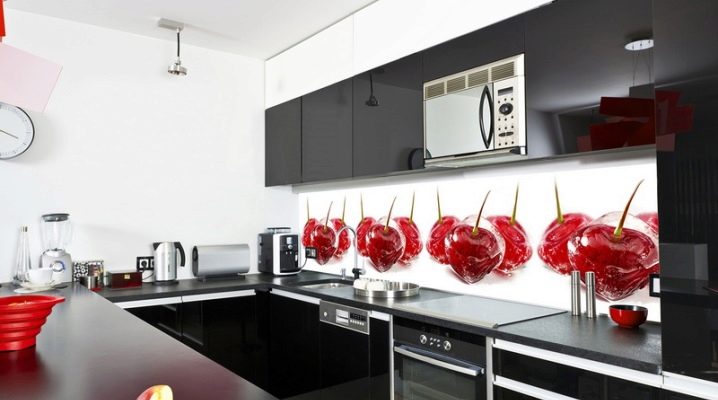
Nutrition is a basic requirement of any living organism, and humans are no exception. That is why the kitchen occupies one of the main places in the houses and apartments of both urban and rural residents. Most often, not only food is prepared here, but also the process of its consumption takes place. This is why choosing the right design and finish is so difficult. When renovating a kitchen, a special approach is needed, because the requirements for the materials used for this room are much higher and more varied than when decorating the rest of the apartment. This is especially true for the work area, the environment next to which is quite aggressive. Modern kitchen skins are one of the best materials for decorating this part of the room.

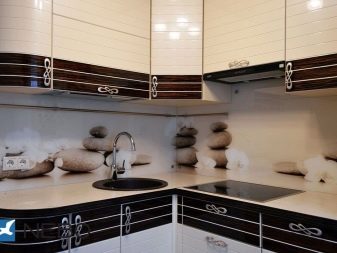
What it is?
Skinali are large glass panels installed in place of a kitchen backsplash. Unlike ordinary glass, the back surface of such a panel is coated with a pattern or pattern using a special technology.
A distinctive feature of this type of finish is the combination of protective and decorative functions. Moreover, the quality of both is an order of magnitude higher than other finishing materials.

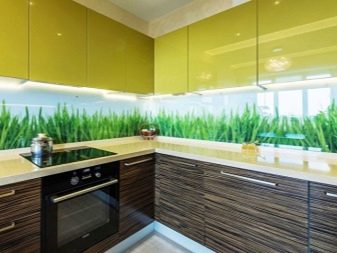
Advantages and disadvantages
After the kitchen skins appeared on sale, they are gaining more and more popularity every year. This is due to the fact that this type of finish has a large number of advantages.
- Heat resistance. Glass is much more resistant to high temperatures than wood or plastic. It will not melt or change its appearance, even if you install such a panel near a gas stove with an open fire. At the same time, glass is much more fireproof than the same wood and even more so plastic.
- Moisture resistance. In addition to being resistant to high temperatures, glass also performs well in constant contact with water. It is not for nothing that this material is the best option for the walls of the shower stall.
- Life time. High-quality skins have a huge margin of safety. Their service life can reach 70-80 years, while their appearance will change very slightly. Landlords are more likely to want to renew their renovations for aesthetic reasons than out of necessity. After all, the simplicity of the design will not allow you to accidentally damage or spoil the apron.
- Design. Modern industry allows you to choose the desired design from a huge variety of different colors, sizes and patterns. In the event that the customer does not want to be limited by the choice of the finished product, the manufacturer will always be able to prepare skins according to the customer's individual design. This allows you to choose the right option for absolutely any interior style, even if it is absolutely extraordinary.
- Environmental friendliness. Glass is one of the safest materials for humans. It is not susceptible to mold and rot, does not emit toxic fumes and does not create a greenhouse effect. The only risk when working with such a surface is getting a cut from a sharp edge. However, modern materials are made so strong that it is simply impossible to break the kitchen skin by accident.
- Ease of installation. It only takes a few hours of work to decorate the kitchen working area with glass panels. At the same time, a large amount of dirt, dust or other waste will not remain in the room.
- Ease of care. Glass is not a porous material, and therefore does not absorb grease and dirt, which are released during the heat treatment of products. The seamless surface does not trap or accumulate plaque and dust. It is easy to clean and dries quickly.
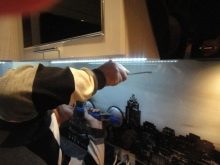
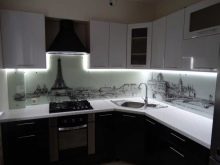
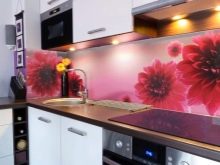
It is worth noting that even such a seemingly ideal material has its drawbacks. Fortunately, there are quite a few of them and they do not outweigh the advantages in any way.
- It is difficult to make holes. A monolithic wall panel without a single hole is not suitable for almost any kitchen. Many household appliances, such as coffee machines, blenders or food processors, are mains powered. This means that there must be at least one outlet next to the work surface. In addition, it is very convenient to integrate various hooks and rails on the apron for storing cutlery or towels. It is very difficult to make an even hole and not damage the skin with your own hands, so you will have to contact professionals and calculate in advance the places of future cutouts in the glass.
- Requires preliminary leveling of the wall. It is simply not possible to qualitatively mount the glass sheet on the wall, even with minimal bumps and dents. The surface is plastered to such a state that it is almost perfectly smooth. And only after that a massive skin is attached to the working area.
- High price. The price of glass products is much higher than plastic or ceramic ones. However, a large number of advantages justify such a gap in the cost of these finishing materials.

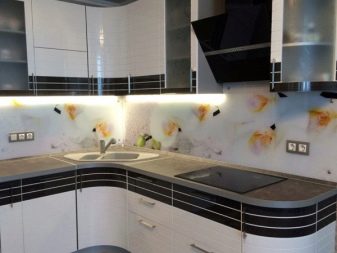
Varieties
A wide variety of colors, images and technical characteristics allows you to choose the perfect skin for the individual needs of the buyer. Most often, they are grouped according to some criterion, so that it is more convenient for the client to navigate when buying.
Popular images
Most often, the selection of wall panels for a kitchen apron begins with the choice of an image. This is what often becomes a determining factor, since any tenant wants the room to be comfortable and pleasing to the eye. All possible decor options can be roughly divided into several large groups.
- Monochrome. Such panels, despite their apparent simplicity, can have a very presentable appearance. Solid does not mean pure white or black. These can be any colors and shades. These skins are the easiest to fit into the interior and combine with the work surface.
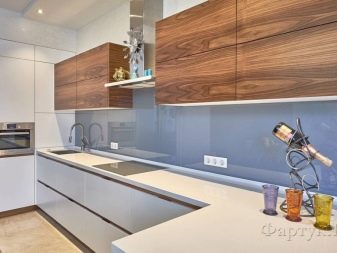

- Patterns, ornaments and abstractions. A small repeating pattern is a great choice for a backsplash. It is less visible dirt and splashes of water, it attracts the eye and becomes a bright accent in the kitchen. At the same time, geometric ornaments can visually change the proportions of a room.
So, for example, horizontal lines will expand the wall, and vertical lines will increase its height.
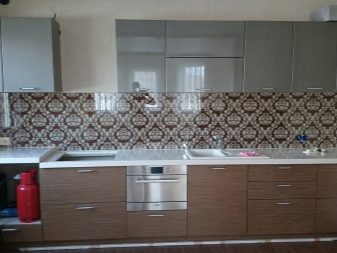
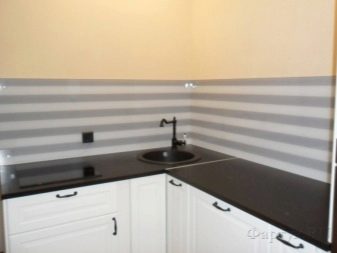
- Natural motives. One of the most popular types of kitchen designs is nature views. These can be pictures of a dense forest, a sea playing with foamy waves, or a sunset sky. Various flowers and shrubs look great. You can choose your favorite landscape of a famous artist or just a good photo.
Photo printing looks especially good in light and wide rooms.
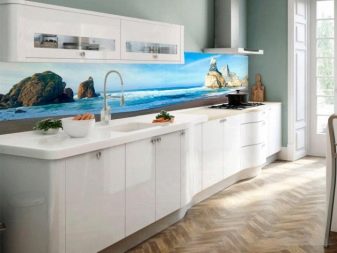
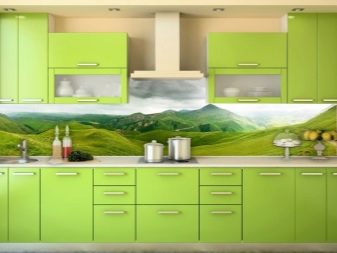
- Animal world. Another popular image suitable for decorating a kitchen wall is various representatives of the animal kingdom. These can be either cute kittens or puppies, as well as graceful deer, tigers or even dolphins.
This design looks especially good if the animal is depicted at the moment of movement, and not just standing or sitting in one place.

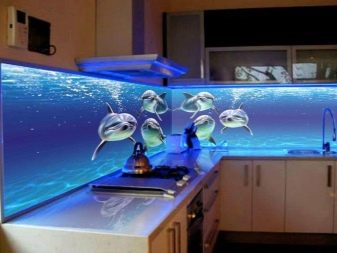
- Everything you can eat and drink. Various culinary products are the classic design for the kitchen. Most often, on the wall of the working area, you can see pictures of beautiful pastries, colorful cocktails or coffee beans and cups.
It is unlikely that someone will dare to place a photo of baked chicken or boiled potatoes on the kitchen wall, but colorful donuts or cakes are an excellent option for decorating an apron.

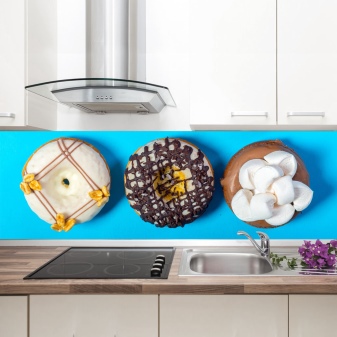
- Urban landscapes. A snowy or night city painted on a wall surface will look better in a bedroom or living room. However, you can also choose a suitable option for the kitchen.
For example, a view of narrow European streets with small cafes or drawbridges would look good on a wide and fairly high surface above the work area.
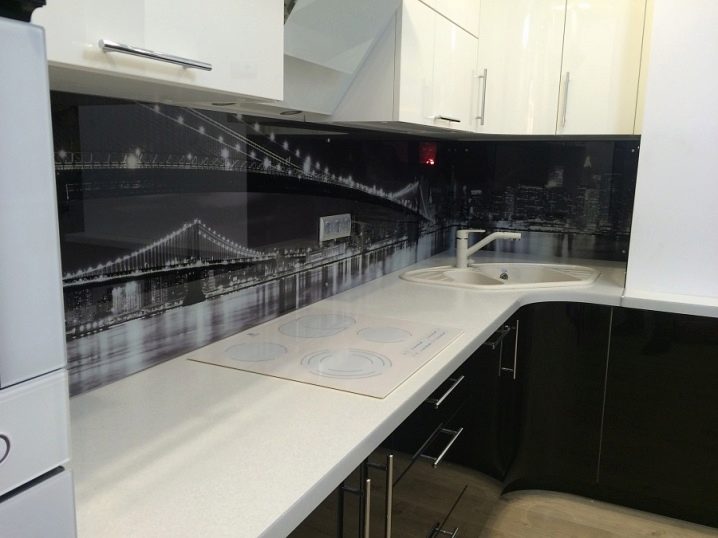
Application technique
Modern technologies make it possible to diversify the technique of applying an image to the surface, to give the interior individual features, even when using standard images. The glass apron can be decorated in the following ways.
- Lakobel. A drawing is applied to the back side of the skin using varnish paints. Most often, such panels are produced in solid colors, but in this technique you can also perform gradient panels or make abstract mixtures of colors and paint streaks. This technique produces a bright glossy color.

- Stencil. The application takes place on a conveyor belt, where the paint is applied to the glass using special stencils. Thus, you can make both one skin, and many copies of it.
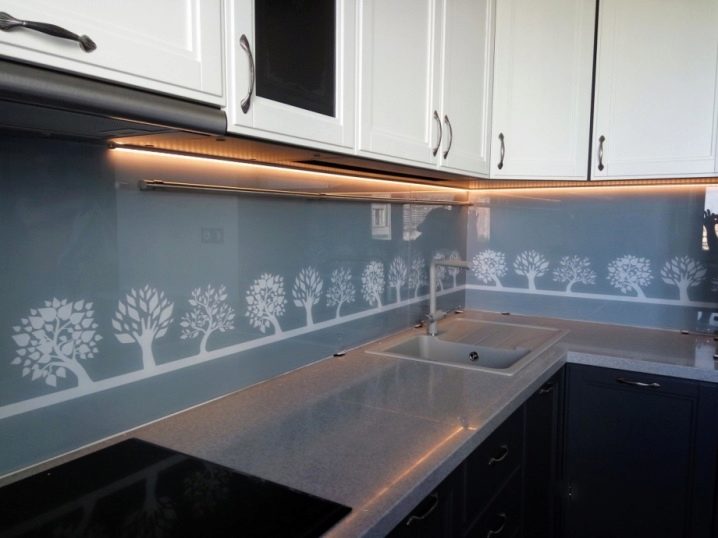
- Lacomat. In this case, a matte translucent varnish is applied to the back surface of the glass, removing the shine and blurring the clear contour. A pattern or drawing can be applied to the top of the varnish.
This effect is highly practical, as it makes small dirt less visible.
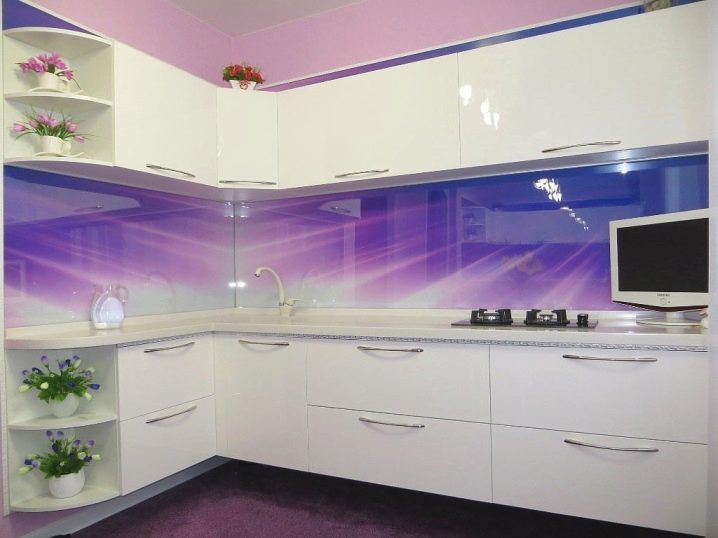
- Mirror. Solid silver paint applied to the back of the glass transforms an ordinary skin into a real mirror. This allows you to visually expand the room, make it brighter.

- Film. The most budgetary option for drawing an image. The desired image is applied to a polymer film with an adhesive base, after which it is glued to the back of the skin.
When choosing this option, special attention should be paid to the quality of the installation. The panel must be flush against the wall, otherwise hot steam or moisture can enter the gaps and damage the film.

- Painting. And this is the least budget option for applying an image. In this case, a professional artist manually paints the back surface of the skin, creating an individual drawing.
At the same time, those buyers who are confident in their artistic skill may well complete such a painting on their own, which will significantly save them money.
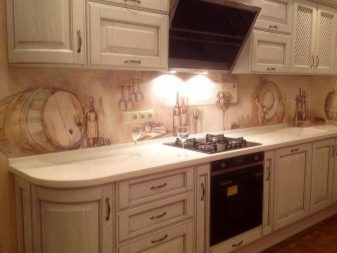
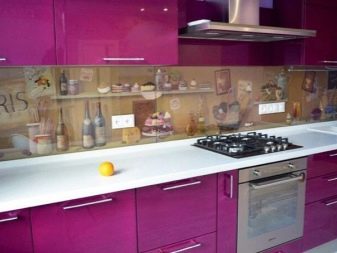
Backlight
Additional lighting of the working area is exactly what many modern housewives and kitchen owners lack so much. An ordinary LED strip acts as an illuminator for the skin, the appearance of the panel will depend on its placement.
- Rear installation. In this version, the glass itself is slightly pushed away from the wall, and a tape with lamps is attached immediately behind it. This option is not bad for mirror surfaces and images obtained by application using the lacomat or lacobel technique. But the film and painting in this case may suffer from the effects of an aggressive environment that gets into the gaps.
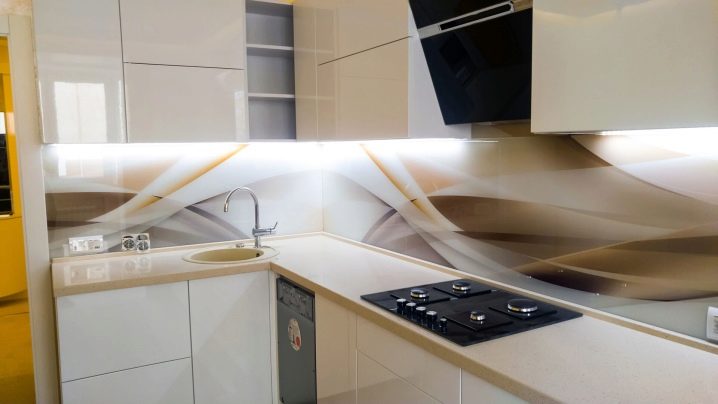
- End installation. In this case, the tape is placed in the uppermost and lowermost part of the glass sheet, which is firmly attached to the wall. Such placement not only protects the back side of the skin, but also better illuminates the drawing itself and the working area of the kitchen.
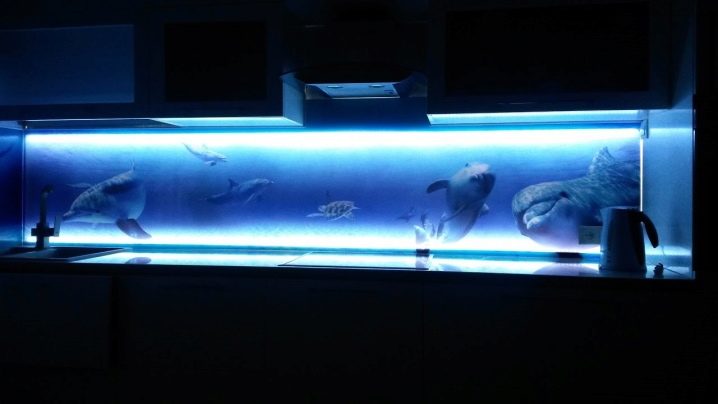
Base material
Another important criterion for the classification of glass kitchen aprons is the main material from which they are made.
- Glass. Regular glass used for installing windows or doors is the least durable option for making skinali. Still, such glass is not recommended to be installed closer than 20-30 centimeters from an open fire, since it can crack from high temperature.Moreover, it is precisely this that allows you to get the brightest and most glossy picture on the wall.
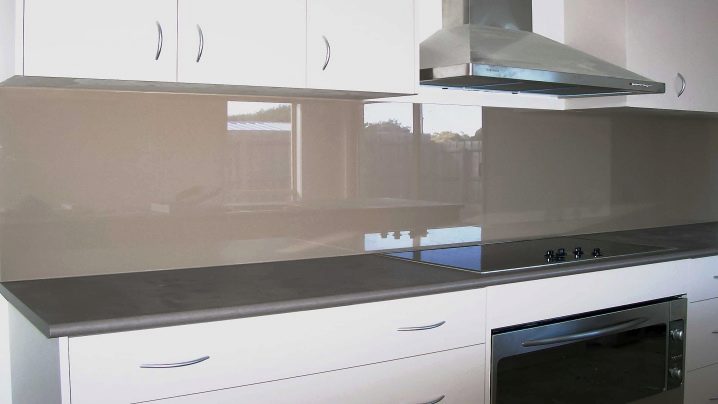
- Strained glass. This material is called stalinite and is heat treated at high temperatures during the production stage. Such hardening allows you to obtain greater strength and fire resistance, so they are not afraid of even direct contact with open fire. Moreover, the cost of such products is an order of magnitude higher than that of ordinary glass.
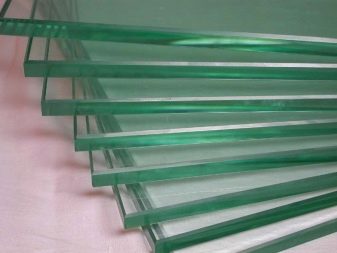
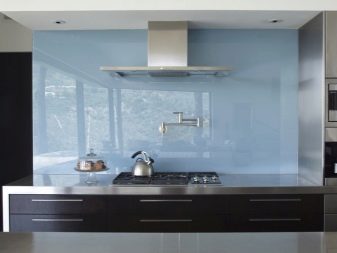
- Triplex. This is a kind of multilayer "sandwich" made of glass and an intermediate film, which prevents the panel from breaking into small fragments. Several layers of film with a translucent pattern allows you to get an unusual 3D effect with a pronounced volume.
Unfortunately, this material is not very transparent and allows you to create a matte, slightly blurry image. Its cost is also significantly higher, as is the weight of the skin itself.
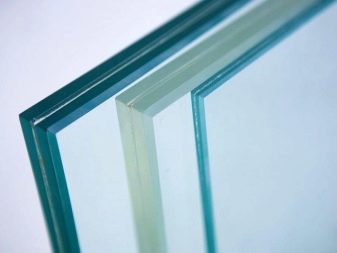
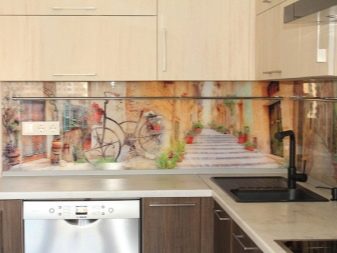
- Plexiglass. This material is very inexpensive, and therefore the finished panels from it have a very affordable price. It can bend slightly and is lightweight, and therefore its installation is much easier than classic glass products. However, its refractoriness and strength are poor.
In addition, the transparency of plexiglass is slightly lower, it does not allow you to get a bright glossy picture.
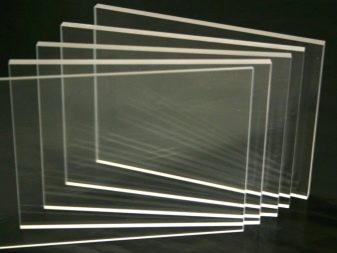
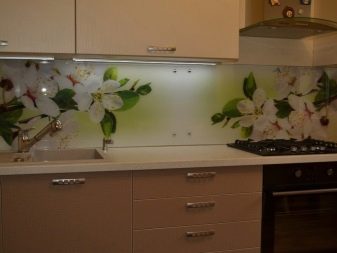
- Polycarbonate. Like plexiglass, this lightweight and comfortable material, unlike ordinary glass, is completely short-lived. It does not tolerate harsh chemicals and is easily scratched. At the same time, it will be a matter of one day to replace such a skin, and it costs quite inexpensively.
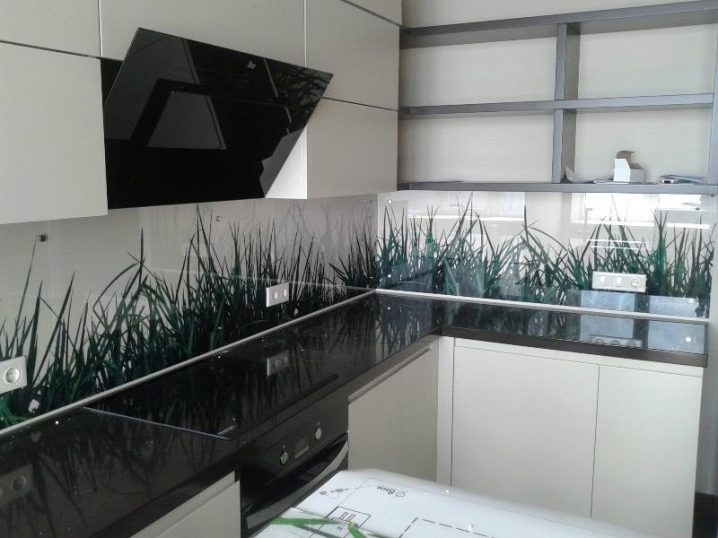
How to choose?
Having studied all the possible types of glass aprons, you can proceed directly to the selection and planning of the purchase. In order for the skins to look great in the kitchen and not cause much trouble, three important rules should be followed.
Combination in the interior
In the case when the client has only a general idea of interior design, he can rely on a simple rule of a novice designer - you should not combine more than three colors in the interior at the same time. Thus, when choosing a color, you should rely on the rest of the interior of the room.
Not only the color, but also the image should be combined with the rest of the style of the room. If there is a large amount of natural materials in the kitchen decoration, the image of space or a night city above the work surface will look very strange. And vice versa, if the rest of the design of the room uses a lot of plastic and tiles of bright colors, then juicy and glossy images of berries or fruits are the best fit for the space between the cabinets.
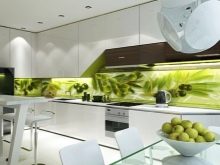


Correct calculation
In order for the brought panel to fit perfectly into its place, it is necessary to make a preliminary calculation as accurate as possible. The dimensions of the panel itself, its thickness and the places of the holes for the hooks and sockets - everything must be verified to the millimeter, otherwise a complex and expensive correction will be necessary.
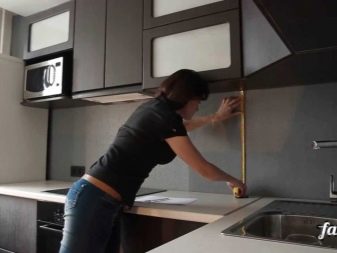

Manufacturer's choice
The most ideal option is to purchase skinals from the same manufacturer from whom the kitchen furniture itself is purchased. However, this is not always possible. In the event that the panel is purchased separately, it is necessary to carefully study various sites and forums for positive and negative customer reviews.
You should not chase an unnecessarily low price or large discounts, this may be associated with low quality of the product. It is better if the client first sees the finished version of the work and assesses its quality before installing it on the wall.

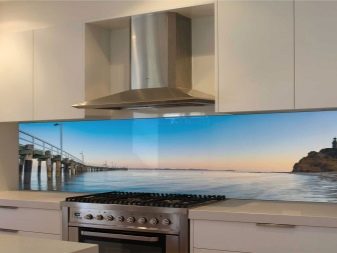
Operating tips
In order for the newly acquired and installed glass panel to retain its brilliance and brightness of colors for many years, it is worth paying special attention to the care of such material. Although durable glass is not as demanding as natural wood or stone, there are a number of recommendations for its use.
- It is best to wipe dust from glass surfaces with a soft, damp microfiber cloth or a special cloth.
- It is better to wash off stains and dirt without aggressive cleaning agents. The ideal option for use is regular soapy water or dishwashing detergent.
- To add shine to your skin, you can use a variety of window and mirror cleaners available at any hardware store.
- A highly diluted, acid-based solution will help against limescale, which often appears near the sink.
- If possible, it is better not to use the distant burners of the gas stove, which are located closer to the glass than the front ones.
- Handle sharp objects and heavy household appliances carefully to avoid chipping and scratching the glass.
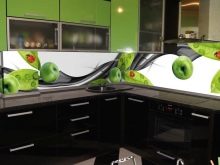

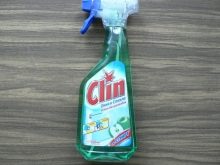
Beautiful examples
For small-sized kitchens, a kitchen apron decor with a small repeating ornament would be a good option. It can be a geometric pattern, a small flower, or mouth-watering sweets.
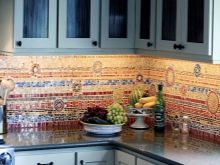
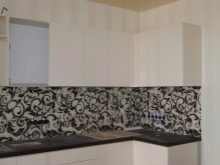

Large rooms with high ceilings go well with both monochromatic glossy surfaces and nature photographs. For example, for a kitchen in orange-yellow colors, you can choose a panel with the image of a beach or a desert, it will perfectly fit into such a color scheme.
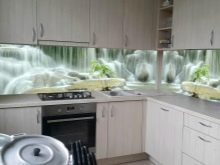

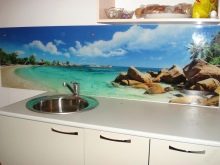
Skinned with family photos or plots of famous books and films look very fresh. Guests will appreciate the taste and originality of the owner of such a kitchen apron.
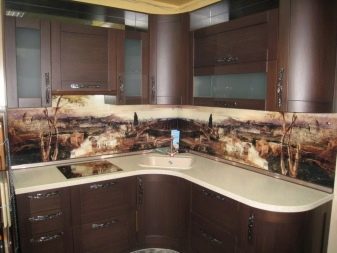
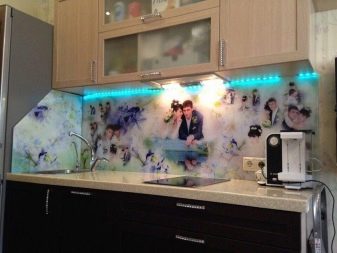
For information on how skinals are made, see the next video.













The comment was sent successfully.